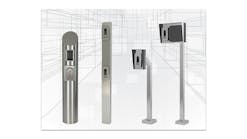Honda introduced the four-track external sidewinder lock mechanism for the 2002 Honda CR-V. The key has six cuts. The door lock uses one full-sized wafer tumbler and seven half-sized wafer tumblers.
This driver's door lock, ASP part # D-19-125, fits the 2002-06 CR-V; 2003-05 Civic; 2002-11 Element; 2003-04 Odyssey and 2004-09 S2000. The lock comes with the Civic pawl. I installed the original pawl onto the new door lock. ASP Honda Keying Kit A-19-108 contains six sizes of half wafers, four sizes of full wafers and springs.
The design of these factory original wafer tumblers is poor. The perch for the key cut is a thin point that wears away or bends after a number of years, requiring the door and ignition lock wafer tumblers be replaced. For this vehicle, the owners mainly used the remotes to unlock the door locks.
Unfortunately, the driver's door lock on this vehicle was attacked by someone using a modified key in an attempt to unlock the driver's door lock. Once this occurred, the operating key had to be jiggled in order to enter completely into the keyway. The damaged wafer tabs required the key to be inserted in a specific angle and jiggled gently until the wafer tumbler move into a position that the key can slide in completely. Once inserted, the key would operate the lock.
The 2002 Honda CR-V door handle assembly is very well secured to the door skin. Removing the handle is impractical for lock replacement. The door lock is inserted into the handle from the rear, which requires removing the door trim panel to gain access. Before the door trim panel can be removed, lower the driver's window to make removal easier. Then remove the inside release handle with power door lock button, the electric window controls with side view mirror controls, two Phillips head screws, side view mirror cover and trim color push pin.
I removed the inside door release cover plate using a dental tool along the top to pull it out. Behind the plate are two Phillips head screws that must be removed. Once the handle was lifted away, the linkage rod and the electrical connection had to be removed.
The window control with side view mirror adjustment was carefully lifted up. Two electrical connectors had to be disconnected.
The push pin was removed using a dental tool and the two Phillps head screws were removed from the front edge and rear edge of the inside pull handle.
Once everything was removed, I carefully pulled off the trim panel. I did not remove the wiring from the trim panel. To provide sufficient room, I rotated the panel 90 degrees.
Next I connected the windows electrical connector and raises the window to have access to the door lock.
I carefully lifted the moisture barrier away from the rear edge of the door and then removed the plastic pin securing the anti-theft sleeve covering the vertical linkage rod. This provided more room to view the door lock. In addition, I removed the 10mm bolt securing the bottom of the rear window track, increasing the ability to view the lock. At best, the view of the door lock is just slightly less than half.
The door lock is secured by a wire lock retainer. This retainer is slid up from the bottom in order to secure the lock in position.
The wire retaining clip is just visible in the opening below the door lock. Use an awl or cotter pin remover that has an approximately 45 -degree bend. The was slid in from the bottom directly beneath the center of the door lock. The difficulty is getting the tool into the opening and above the retaining clip.
The retaining clip was pulled out from the bottom. If the clip is bent, it should be reshaped to look even.
The vertical linkage rod was removed from the pawl. For this vehicle, there was no clip that had to be disengaged.
The lock was gently out of the handle assembly. Normally the door lock does not need to be replaced. However the person who tried to gain entry damaged the plug.
The ASP Honda Door lock was coded to a key. I disassembled the lock and removed the eight wafers. I used the ASP Honda Keying Kit to code the lock to the provided key. No replacement parts are required if the lock is disassembled and reassembled.
I photographed the old lock's disassembly to ensure the correct replacement wafers. To determine the proper wafer depths, I read the stamped numbers where available or compared the old and new wafers. I loaded one wafer at a time and used the owner’s keys to check. This door lock is double-throw, meaning adjacent wafers load from top and bottom. I carefully loaded the wafers as they do not snap into place and will fall out when inverted.
Once the one full sized wafer tumblers and the seven half sized wafer tumblers were inserted, I inserted the key and made sure no wafer tumblers extended from the plug. The combinated plug was installed into the housing. The plug fits in one direction. The weep hole in the plug aligns with the tab cutout in the housing. The weep hole is along the bottom of the lock. If the plug is inserted 180 degrees out, the plug will not slide completely into the housing.
I removed the plug and lubricated it with a lithium-based grease to help insure operational longevity.
The door lock was inserted into the area of the opening. It did not want to slide in easily. I inserted the operating key into the keyway of the door lock through the opening in the handle. This allowed me to adjust the position of my arm and hand to slide the door lock into the opening in the handle assembly.
I slid the wire retaining clip into the opening and with a bit of jiggling of the key to reposition the lock, I was able to slide the clip into position, securing the lock.






